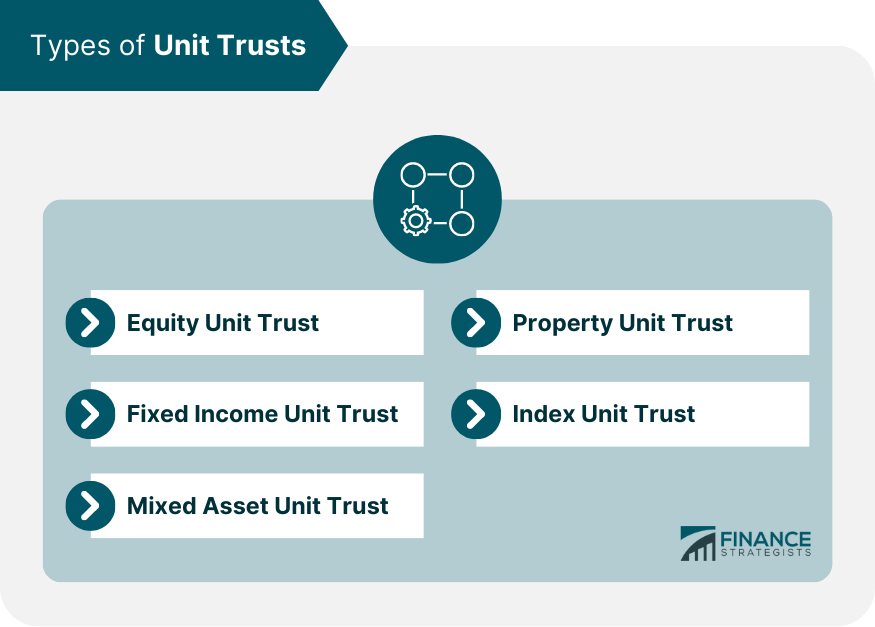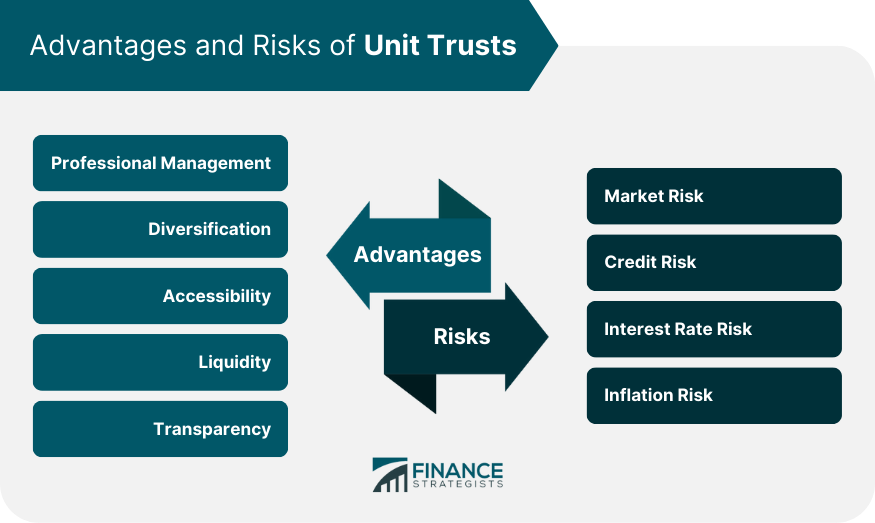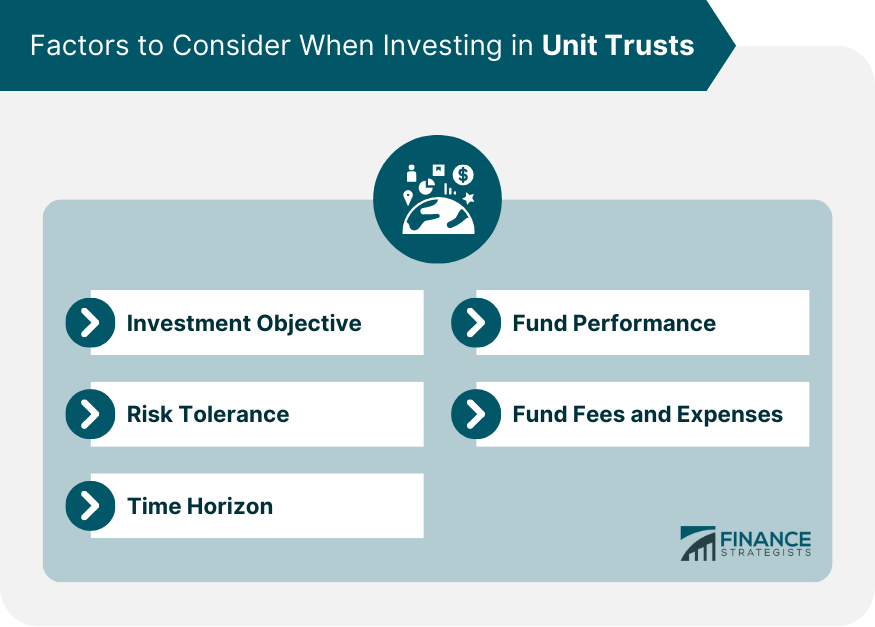A Unit Trust is a form of collective investment vehicle that allows investors to pool their funds together to be managed by a professional fund manager. These pooled funds are then invested in a diverse portfolio of assets such as stocks, bonds, and other securities. Each investor holds units that represent their share of the total fund's assets. As the value of the underlying assets in the portfolio fluctuates, so does the value of each unit. Unit Trusts offer a flexible and convenient investment option for individuals seeking to benefit from the financial markets' growth without having to manage their investments actively. In addition, by investing in a Unit Trust, investors gain access to a diverse range of investment opportunities that they might not have been able to access individually. Unit Trusts originated in the United Kingdom in the early 1930s as a way for small investors to gain exposure to the stock market. The idea was to create a vehicle that allowed investors to pool their funds, providing them with access to a diversified investment portfolio managed by professionals. The first Unit Trust was launched in 1931 by M&G Investments, and it focused on investing in British and international equities. The concept of Unit Trusts has since spread globally, with many countries adopting similar investment vehicles under various names, such as mutual funds in the United States. Over time, the range of assets and investment strategies available to Unit Trusts has expanded, catering to a broader audience with varying investment goals and risk appetites. Today, Unit Trusts represent a significant portion of the global investment landscape, providing millions of investors with a convenient and cost-effective way to invest in a wide range of assets. Equity Unit Trusts primarily invest in stocks or shares of publicly traded companies. These funds seek to generate capital appreciation by investing in companies with strong growth potential or those that are undervalued by the market. Equity funds can be further divided into various subcategories, such as large-cap, small-cap, and sector-specific funds, allowing investors to tailor their investments to their preferences and risk tolerance. Equity Unit Trusts are typically considered higher risk than other types of Unit Trusts, as they are more exposed to market fluctuations. However, they also have the potential for higher returns, particularly over the long term, as equities have historically outperformed other asset classes. Fixed Income Unit Trusts invest mainly in debt securities such as government and corporate bonds. These funds generate income through the regular interest payments from the bonds held in their portfolios. Fixed income funds aim to provide investors with a stable income stream while preserving their capital. Investors seeking lower risk and more predictable returns often prefer Fixed Income Unit Trusts. While they generally offer lower potential returns than equity funds, their lower risk profile makes them an attractive option for conservative investors or those seeking to balance their overall portfolio risk. Mixed Asset Unit Trusts, also known as balanced or diversified funds, invest in a combination of equities and fixed income securities. These funds aim to strike a balance between capital appreciation and income generation, allowing investors to enjoy the best of both worlds. The allocation between equities and fixed income securities varies depending on the fund's investment strategy and risk profile. Mixed Asset Unit Trusts are suitable for investors seeking a more balanced investment approach, offering a combination of growth and income potential. These funds can help to smooth out investment returns over time, as the different asset classes may perform differently in various market conditions. Property Unit Trusts focus on investing in real estate assets, either directly or through shares in property companies and real estate investment trusts (REITs). These funds aim to generate returns through rental income, capital appreciation, or a combination of both. Property Unit Trusts offer investors a convenient way to access the real estate market without the need to buy and manage individual properties. Investing in Property Unit Trusts can provide portfolio diversification and a hedge against inflation, as property values and rental income often rise over time. However, these funds may be subject to property market fluctuations and specific risks associated with the real estate sector, such as changes in property laws, interest rates, and economic conditions. Index Unit Trusts, also known as passive or tracker funds, aim to replicate the performance of a specific market index, such as the S&P 500 or the FTSE 100. These funds invest in the same assets and proportions as the index they track, providing investors with a low-cost and straightforward way to gain exposure to a broad market segment. Index Unit Trusts are ideal for investors seeking a passive investment approach, as they require minimal management and often have lower fees compared to actively managed funds. However, investors should note that the performance of these funds will closely follow the underlying index, meaning that they will not outperform the market. One of the main advantages of investing in Unit Trusts is that they are managed by professional fund managers with extensive experience and expertise in the financial markets. These managers are responsible for selecting the assets to include in the portfolio, monitoring their performance, and making adjustments as needed to meet the fund's investment objectives. This means that investors can benefit from their knowledge and skills without having to devote time and resources to managing their investments actively. Unit Trusts allow investors to access a diversified portfolio of assets, spreading their investment across a wide range of securities. This diversification can help to reduce overall portfolio risk, as the performance of individual assets is unlikely to be perfectly correlated. In other words, if one asset performs poorly, it may be offset by the strong performance of another. By investing in a diversified Unit Trust, investors can mitigate the impact of individual asset fluctuations and create a more stable investment portfolio. Unit Trusts are accessible to a wide range of investors, with many funds requiring only a small initial investment. This makes them an ideal choice for individuals who may not have the capital or expertise to invest directly in individual securities. Furthermore, Unit Trusts are widely available through various distribution channels, including banks, investment platforms, and financial advisors, making it easy for investors to find and invest in suitable funds. Investing in Unit Trusts offers a high degree of liquidity, as investors can generally buy or sell their units on any business day. This flexibility allows investors to access their funds quickly if needed, making Unit Trusts an attractive option for those seeking a liquid investment vehicle. It's important to note, however, that the liquidity of a Unit Trust may be affected by the underlying assets in which it invests. For example, funds invested in illiquid assets, such as certain types of property, may be more challenging to buy or sell quickly. Unit Trusts are subject to strict regulations and disclosure requirements, ensuring a high level of transparency for investors. Fund managers must provide regular updates on the fund's performance, portfolio holdings, and fees, allowing investors to make informed decisions about their investments. This transparency also allows investors to monitor the fund's progress and ensure that it aligns with their investment objectives and risk tolerance. Market risk refers to the potential for an investment's value to decrease due to fluctuations in the overall financial markets. As Unit Trusts invest in various securities, they are exposed to the ups and downs of the markets in which they operate. While diversification within the fund can help mitigate some of this risk, it is essential for investors to understand that the value of their investment in a Unit Trust can still fluctuate with market conditions. Credit risk is the risk that an issuer of a debt security, such as a bond, will default on their interest or principal payments. Fixed Income Unit Trusts, which invest primarily in debt securities, are exposed to credit risk. The degree of credit risk depends on the creditworthiness of the issuers in the fund's portfolio. To manage credit risk, fund managers often diversify their holdings across various issuers and credit ratings. Interest rate risk refers to the potential for an investment's value to decrease as interest rates rise. Fixed income securities, such as bonds, are particularly sensitive to interest rate fluctuations, as their value tends to decrease when interest rates increase. Fixed Income Unit Trusts are exposed to interest rate risk, which can affect their overall performance. Investors should be aware of this risk, especially in a rising interest rate environment. Inflation risk is the risk that the purchasing power of an investment's returns will be eroded over time due to rising inflation. Fixed income securities, such as bonds, are generally more exposed to inflation risk, as their interest payments may not keep up with inflation. As a result, Fixed Income Unit Trusts may be subject to inflation risk, potentially reducing the real return on investment. Investors should consider the potential impact of inflation on their investment returns and may choose to diversify their portfolio to include assets that offer a hedge against inflation, such as equities or property. Before investing in a Unit Trust, it is essential to determine your investment objectives. These objectives may include capital growth, income generation, or a combination of both. Understanding your investment goals will help you select the most suitable type of Unit Trust that aligns with your needs and preferences. Investing in Unit Trusts involves varying degrees of risk, depending on the assets and investment strategies employed by the fund. As an investor, it is crucial to assess your risk tolerance and choose a fund that matches your comfort level with risk. Generally, higher-risk investments have the potential for higher returns but also increased volatility, while lower-risk investments tend to offer more stable returns but with less potential for capital growth. Your investment time horizon, or the length of time you plan to hold your investment, is another important factor to consider when selecting a Unit Trust. Generally, investors with longer time horizons can afford to take on more risk, as they have more time to recover from potential market downturns. In contrast, investors with shorter time horizons may want to prioritize capital preservation and choose lower-risk funds. While past performance is not a guarantee of future results, analyzing a fund's historical performance can provide valuable insights into its potential for success. It is essential to evaluate a fund's performance over various timeframes and market conditions, comparing it to relevant benchmarks and peer groups. Additionally, consider the fund manager's track record and expertise in managing similar funds. Unit Trusts charge various fees and expenses, which can impact your investment returns. These fees may include management fees, sales charges, and ongoing expenses, such as administrative and custodial costs. When comparing funds, it is important to consider the total cost of ownership and select a fund with reasonable fees that align with the services and potential returns provided. The first step in investing in a Unit Trust is selecting a provider. Providers may include banks, asset management companies, or investment platforms. When choosing a provider, consider factors such as the range of funds offered, the provider's reputation, and the quality of customer service. Additionally, compare the fees associated with different providers, such as account opening or maintenance fees, to ensure you choose the most cost-effective option. Once you have selected a provider, the next step is to open a Unit Trust account. This process typically involves completing an application form, providing personal identification documents, and depositing the initial investment amount. Some providers may also require investors to complete a risk assessment questionnaire to help determine the most suitable funds based on their risk tolerance and investment objectives. With your account open, the next step is to select the appropriate Unit Trust to invest in. Consider factors such as the fund's investment objective, risk profile, performance history, and fees. Additionally, review the fund's prospectus, which provides detailed information on the fund's investment strategy, risks, and expenses. By carefully evaluating and comparing different funds, you can select the Unit Trust that best aligns with your investment goals and risk tolerance. Once you have chosen a suitable Unit Trust, the final step is to place an investment order. This process typically involves specifying the amount you wish to invest, either in terms of a monetary value or a number of units. Some Unit Trust providers may offer the option to invest via a lump sum, regular monthly contributions, or a combination of both. After placing your order, the provider will execute the transaction and allocate the units to your account. By investing in a Unit Trust, investors gain access to a diverse range of investment opportunities that they might not have been able to access individually. There is a wide array of Unit Trust types to choose from, such as equity, fixed income, mixed asset, property, and index funds. Each type caters to different investment objectives and risk tolerances, allowing investors to tailor their investments according to their preferences. It is essential to understand the characteristics and risks associated with each type of Unit Trust to make informed investment decisions. Investing in Unit Trusts offers several advantages, including professional management, diversification, accessibility, liquidity, and transparency. However, they also come with inherent risks, such as market, credit, interest rate, and inflation risks. Investors should carefully consider these advantages and risks when evaluating Unit Trusts as part of their overall investment strategy. To successfully invest in Unit Trusts, follow a step-by-step process that includes selecting a provider, opening an account, choosing the right fund, and placing an investment order. By considering factors such as investment objectives, risk tolerance, time horizon, fund performance, and fees, investors can select a suitable Unit Trust to help achieve their financial goals. What Is a Unit Trust?
History and Development of Unit Trusts
Types of Unit Trusts
Equity Unit Trust
Fixed Income Unit Trust
Mixed Asset Unit Trust
Property Unit Trust
Index Unit Trust

Advantages of Unit Trusts
Professional Management
Diversification
Accessibility
Liquidity
Transparency
Risks of Unit Trusts
Market Risk
Credit Risk
Interest Rate Risk
Inflation Risk

Factors to Consider When Investing in Unit Trusts
Investment Objective
Risk Tolerance
Time Horizon
Fund Performance
Fund Fees and Expenses

How to Invest in Unit Trusts
Selecting a Unit Trust Provider
Opening a Unit Trust Account
Choosing the Right Unit Trust
Placing an Investment Order
Final Thoughts
Unit Trust (UT) FAQs
Unit Trust is a collective investment vehicle that pools money from many investors to invest in a portfolio of securities, managed by a professional fund manager.
Unit Trusts offer diversification, professional management, accessibility, liquidity, and transparency.
Investing in Unit Trusts involves market risk, credit risk, interest rate risk, and inflation risk.
You can invest in Unit Trusts by selecting a Unit Trust provider, opening a Unit Trust account, choosing the right Unit Trust, and placing an investment order.
You should consider your investment objective, risk tolerance, time horizon, fund performance, and fund fees and expenses before investing in a Unit Trust.
True Tamplin is a published author, public speaker, CEO of UpDigital, and founder of Finance Strategists.
True is a Certified Educator in Personal Finance (CEPF®), author of The Handy Financial Ratios Guide, a member of the Society for Advancing Business Editing and Writing, contributes to his financial education site, Finance Strategists, and has spoken to various financial communities such as the CFA Institute, as well as university students like his Alma mater, Biola University, where he received a bachelor of science in business and data analytics.
To learn more about True, visit his personal website or view his author profiles on Amazon, Nasdaq and Forbes.











